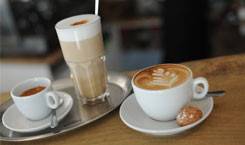Espresso preparation
How do Italians love their espresso? Here you will find the most popular Italian espresso versions.
Espresso, Cappuccino, Latte Macchiato - Italian Variations
Espresso
 For the perfect espresso you need about 7g of coffee and 25ml of water. Hazelnut colours, intense aroma, creamy and soft taste, served in a thick-walled espresso cup. In Italy, espresso is simply called un caffè (the full name is caffè espresso), and you should drink it in a few sips - it sets the tone after dinner and during the day.
For the perfect espresso you need about 7g of coffee and 25ml of water. Hazelnut colours, intense aroma, creamy and soft taste, served in a thick-walled espresso cup. In Italy, espresso is simply called un caffè (the full name is caffè espresso), and you should drink it in a few sips - it sets the tone after dinner and during the day.
Lungo
 An "extended" espresso with twice the amount of water and longer brewing time for the same amount of coffee - ideal after a meal!
An "extended" espresso with twice the amount of water and longer brewing time for the same amount of coffee - ideal after a meal!
Ristretto
 "Limited" espresso for true espresso lovers: you only need 15 ml of water and the same amount of coffee for the strongest and most concentrated espresso. Very strong and aromatic - perfect in the morning!
"Limited" espresso for true espresso lovers: you only need 15 ml of water and the same amount of coffee for the strongest and most concentrated espresso. Very strong and aromatic - perfect in the morning!
Doppio

Double dose of espresso and double amount of water served in a cappuccino cup.
Corretto
 With a shot (approx. 10 ml) of grappa, brandy or liqueur "corrected" espresso - ideal for cold winter days!
With a shot (approx. 10 ml) of grappa, brandy or liqueur "corrected" espresso - ideal for cold winter days!
Macchiato
 In Italy, the espresso is often poured with a small sip of milk for refinement. Espresso macchiato ("spotted" espresso) is also often crowned with a small cap of foamed milk.
In Italy, the espresso is often poured with a small sip of milk for refinement. Espresso macchiato ("spotted" espresso) is also often crowned with a small cap of foamed milk.
Marocchino
 The classic espresso is sprinkled with cocoa powder, then cream is carefully added and again covered with cocoa powder. The Marocchino is served in glass cups. With the Marocchino Bicerin, melted chocolate is added to the bottom of the glass cup.
The classic espresso is sprinkled with cocoa powder, then cream is carefully added and again covered with cocoa powder. The Marocchino is served in glass cups. With the Marocchino Bicerin, melted chocolate is added to the bottom of the glass cup.
Cappuccino
 Usually one third espresso, one third boiled milk and one third foam, served in a ceramic cup (approx. 200 ml) and often refined with some cocoa on the foam. Italian variations are cappuccino senza fiuma (without foamed milk), cappuccino chiaro ("light" cappuccino with less espresso and more boiled milk) and cappuccino scuro ("darker" cappuccino with more espresso and less milk).
Usually one third espresso, one third boiled milk and one third foam, served in a ceramic cup (approx. 200 ml) and often refined with some cocoa on the foam. Italian variations are cappuccino senza fiuma (without foamed milk), cappuccino chiaro ("light" cappuccino with less espresso and more boiled milk) and cappuccino scuro ("darker" cappuccino with more espresso and less milk).
It is the most popular breakfast drink in Italy, but is also enjoyed with a sweet pastry. This coffee got its name from the hood - the "cappuccio" - of the order habit of the Capuchin monks. Their brown frocks are reminiscent of the colour of the popular drink, which is translated as "little Capuchin".
Latte Macchiato
 The latte macchiato consists of three layers: a bottom layer of hot milk (2/3), a top layer of frothed milk (1/3) and an espresso poured through the frothed milk. Since fatty milk has a higher density than espresso, the coffee floats on the milk.
The latte macchiato consists of three layers: a bottom layer of hot milk (2/3), a top layer of frothed milk (1/3) and an espresso poured through the frothed milk. Since fatty milk has a higher density than espresso, the coffee floats on the milk.
In contrast to milk coffee or café au lait, which are prepared with strong filter coffee instead of espresso, latte macchiato is served in a glass. As with cappuccino, the following applies: do not drink before or after a meal, but in the morning as a breakfast drink or in between as a break drink.
Cafè Latte
 This milk coffee, often drunk for breakfast, consists of a double espresso in a large cup of boiled milk and is covered with little or no milk foam.
This milk coffee, often drunk for breakfast, consists of a double espresso in a large cup of boiled milk and is covered with little or no milk foam.
Caffè Moca
 Serve approx. one third espresso, one third boiled milk and one third cocoa in a tall glass. The drink can also be made with 1 to 2 tablespoons of chocolate syrup and more milk.
Serve approx. one third espresso, one third boiled milk and one third cocoa in a tall glass. The drink can also be made with 1 to 2 tablespoons of chocolate syrup and more milk.
Caffè Americano
 This involves lengthening an espresso with the same amount of hot water again (Attention: do not pour twice as much water through the machine as you do in the cup first!) According to many, it replaces a filter coffee.
This involves lengthening an espresso with the same amount of hot water again (Attention: do not pour twice as much water through the machine as you do in the cup first!) According to many, it replaces a filter coffee.
Caffe Freddo
 This is a strongly sweetened espresso extended with water, which - well cooled - is mainly served in summer.
This is a strongly sweetened espresso extended with water, which - well cooled - is mainly served in summer.
And there's that too...
sospenso
(Ital.: "Recovered"): An espresso for a good cause - "C'e un Sospenso?" you can hear it calling every day in the coffee bars of Naples. This means "Is there a person in the public domain?" and is rooted in an ancient Neapolitan tradition of helping. The principle: If you had a good day, if you have succeeded in doing a good business or if you simply want to make a social contribution, you order a "Sospenso". In other words, you drink an espresso and pay for two. If someone comes along who cannot afford an espresso due to his poverty, he asks for the "picked up" one and can drink it for free. In this way, people who are ill can also participate in social life.

